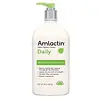What's inside
What's inside
 Key Ingredients
Key Ingredients

 Benefits
Benefits

 Concerns
Concerns

 Ingredients Side-by-side
Ingredients Side-by-side

Water
Skin ConditioningAmmonium Lactate
BufferingC12-15 Alkyl Benzoate
AntimicrobialGlycerin
HumectantPrunus Amygdalus Dulcis Oil
Skin ConditioningEthylhexyl Palmitate
EmollientCetearyl Alcohol
EmollientGlyceryl Stearate
EmollientPEG-100 Stearate
Dimethicone
EmollientHydroxyethylcellulose
Emulsion StabilisingPhenoxyethanol
PreservativeCetearyl Glucoside
EmulsifyingXanthan Gum
EmulsifyingSodium Benzoate
MaskingSodium Stearoyl Glutamate
CleansingTocopheryl Acetate
AntioxidantParfum
MaskingPotassium Sorbate
PreservativePentylene Glycol
Skin ConditioningHydrolyzed Milk Protein
Skin ConditioningDisodium EDTA
Lactic Acid
BufferingSerine
MaskingSodium Lactate
BufferingSorbitol
HumectantUrea
BufferingLinalool
PerfumingCitronellol
PerfumingSodium Chloride
MaskingCitrus Aurantium Dulcis Oil
MaskingLimonene
PerfumingCoumarin
PerfumingJuniperus Mexicana Oil
MaskingAlpha-Isomethyl Ionone
PerfumingAllantoin
Skin ConditioningPelargonium Graveolens Oil
MaskingGeraniol
PerfumingWater, Ammonium Lactate, C12-15 Alkyl Benzoate, Glycerin, Prunus Amygdalus Dulcis Oil, Ethylhexyl Palmitate, Cetearyl Alcohol, Glyceryl Stearate, PEG-100 Stearate, Dimethicone, Hydroxyethylcellulose, Phenoxyethanol, Cetearyl Glucoside, Xanthan Gum, Sodium Benzoate, Sodium Stearoyl Glutamate, Tocopheryl Acetate, Parfum, Potassium Sorbate, Pentylene Glycol, Hydrolyzed Milk Protein, Disodium EDTA, Lactic Acid, Serine, Sodium Lactate, Sorbitol, Urea, Linalool, Citronellol, Sodium Chloride, Citrus Aurantium Dulcis Oil, Limonene, Coumarin, Juniperus Mexicana Oil, Alpha-Isomethyl Ionone, Allantoin, Pelargonium Graveolens Oil, Geraniol
 Reviews
Reviews

Ingredients Explained
These ingredients are found in both products.
Ingredients higher up in an ingredient list are typically present in a larger amount.
Ammonium lactate is derived from lactic acid and is considered an AHA. It is often used to treat very dry, rough, or itchy skin.
At 12% strength, this ingredient has been shown to do more than just moisturize. Studies show it can increase skin thickness, boost natural hyaluronic acid in skin, and improve overall firmness/elasticity.
You'll likely see this ingredient in eczema treatments. Many OTC products contain this ingredient (up to 10%), but stronger versions (30%) are only available by prescription in many countries.
According to the Cosmetic Use Guidelines (CIR Expert Panel), this ingredient is safe to use at ≤10% with pH ≥3.5, provided sun protection is included. Like all AHAs, ammonium lactate makes your skin more sensitive to the sun (daily sun protection is a mustl). Without it, UV exposure can lead to damage and undo the benefits of treatment.
Be sure to listen to your medical provider when using prescription ammonium lactate.
Learn more about Ammonium LactateDimethicone is a type of synthetic silicone created from natural materials such as quartz.
What it does:
Dimethicone comes in different viscosities:
Depending on the viscosity, dimethicone has different properties.
Ingredients lists don't always show which type is used, so we recommend reaching out to the brand if you have questions about the viscosity.
This ingredient is unlikely to cause irritation because it does not get absorbed into skin. However, people with silicone allergies should be careful about using this ingredient.
Note: Dimethicone may contribute to pilling. This is because it is not oil or water soluble, so pilling may occur when layered with products. When mixed with heavy oils in a formula, the outcome is also quite greasy.
Learn more about DimethiconeGlycerin is already naturally found in your skin. It helps moisturize and protect your skin.
A study from 2016 found glycerin to be more effective as a humectant than AHAs and hyaluronic acid.
As a humectant, it helps the skin stay hydrated by pulling moisture to your skin. The low molecular weight of glycerin allows it to pull moisture into the deeper layers of your skin.
Hydrated skin improves your skin barrier; Your skin barrier helps protect against irritants and bacteria.
Glycerin has also been found to have antimicrobial and antiviral properties. Due to these properties, glycerin is often used in wound and burn treatments.
In cosmetics, glycerin is usually derived from plants such as soybean or palm. However, it can also be sourced from animals, such as tallow or animal fat.
This ingredient is organic, colorless, odorless, and non-toxic.
Glycerin is the name for this ingredient in American English. British English uses Glycerol/Glycerine.
Learn more about GlycerinPotassium Sorbate is a preservative used to prevent yeast and mold in products. It is commonly found in both cosmetic and food products.
This ingredient comes from potassium salt derived from sorbic acid. Sorbic acid is a natural antibiotic and effective against fungus.
Both potassium sorbate and sorbic acid can be found in baked goods, cheeses, dried meats, dried fruit, ice cream, pickles, wine, yogurt, and more.
You'll often find this ingredient used with other preservatives.
Learn more about Potassium SorbateWater. It's the most common cosmetic ingredient of all. You'll usually see it at the top of ingredient lists, meaning that it makes up the largest part of the product.
So why is it so popular? Water most often acts as a solvent - this means that it helps dissolve other ingredients into the formulation.
You'll also recognize water as that liquid we all need to stay alive. If you see this, drink a glass of water. Stay hydrated!
Learn more about WaterXanthan gum is used as a stabilizer and thickener within cosmetic products. It helps give products a sticky, thick feeling - preventing them from being too runny.
On the technical side of things, xanthan gum is a polysaccharide - a combination consisting of multiple sugar molecules bonded together.
Xanthan gum is a pretty common and great ingredient. It is a natural, non-toxic, non-irritating ingredient that is also commonly used in food products.
Learn more about Xanthan Gum